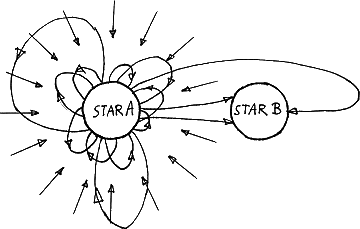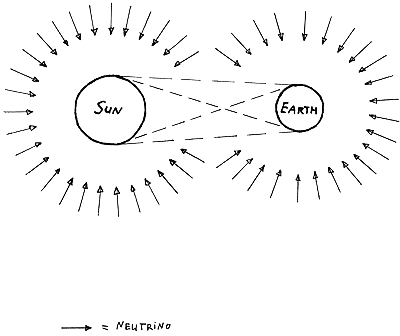 Figure 3-2-I
Gravity as a repulsive force. Gravity particles
Perhaps gravity particles cause the repulsive force instead of neutrinos. Maybe the whole universe is filled with gravity particles that push like Gelman has proposed with neutrinos. Gravity particles may be going in and out of all matter continually.
[May 2003: To my big surprise I discovered that Gelman had re-invented the pushing gravity idea. In August 2002 I read the great book Pushing Gravity5 (edited by Edwards) in which it is pointed out that it was Nicolas Fatio de Duillier (1664-1753) who was the first to have pushing gravity ideas on the cause of gravity. After Fatio's death Georges-Louis Le Sage (1724-1803) rescued Fatio's ideas, after having re-invented pushing gravity himself, from complete oblivion. The basic idea of pushing gravity is that matter sends out and receives gravity particles (or gravitons, as they are generally addressed), thus causing a pushing gravity force overall resulting in mass “attracting” other mass (by pushing). End May 2003] If gravity is caused by gravity particles then: all mass is influenced by inertial forces because of gravity particles. If so then we are back at the principle of Ernst Mach (1838-1916), better known as Mach's principle, which states that all inertial forces are due to the distribution of matter in the universe6.
We may also go back to George Berkeley (1685-1753). To Berkeley and many other philosophers of science it seemed natural to suppose that space in all respects was subordinate to matter and that the properties attributed by Newton to absolute space were in fact the result of the material content of the universe6. [May 2003: Sooner or later everybody comes to Newton (1642-1726) to set the record straight. Nicolas Fatio de Duillier tried to make Newton consider the alternative concept of gravity which did not violate the causality principle. But Newton held on to objects acting on each other without intermediaries passing between the objects to convey the action and thus drifted off into postulates plus mathematics and so did conventional science ever after. End May 2003]
Brush16 thought that gravity is in fact merely longwave radiation pushing masses together. Hit-chance
From 1986 to 1990 there has been a controversy about experiments by Fischbach and Aronson24. They claimed that they had measured that different materials fall with different velocities in vacuum: the more compact the nuclei in the atoms of the material the slower the velocity. No one could reproduce their experiments and therefore the controversy has died away.
With gravity particles causing gravity forces it may be easy to understand why an object with a certain mass and certain density may fall faster (in vacuum) than another object with the same mass but a higher density (i.e. less compact nuclei in the atoms): with a higher “nuclei-volume” there is more chance to get “hit” by gravity particles. This may also explain why hydrogen clouds may move faster than dust when attracted by large amounts of mass, for instance a galaxy. (If a high density object is slowed down less because of pushing gravity (i.e. inertial forces by gravity particles) then the opposite happens too: gas clouds speed up faster than dust when attracted by gravity. Or: dust gets attracted slower than hydrogen gas, see also 4-3. But: an individual hydrogen atom (especially an HII particle, having no electron) may be something else than a hydrogen cloud: an individual hydrogen atom (not in a cloud) may be speeded up slower than a dust particle, depending on the densities of the individual hydrogen atom and the dust particle.) [May 2003: For the same hit-chance reason a plate may fall faster when it falls horizontal (in vacuum) than when it falls vertical (see Dr. Thomas van Flandern in Pushing Gravity5).
With gravity as a repulsive force by gravity particles it may make a difference whether a certain mass M has a large volume and low density or a small volume and a high density.
For example: imagine mass M to be (almost) infinite small with an (almost) infinite density, thus gravity particles can not hit M that much, because gravity particles occupy a certain part of space as well as photons (or cosmic microwave background radiation) in space or airmolecules in our atmosphere. This may mean that it is (in essence) wrong to look at gravity as if a mass M were a point mass, as in the case of Newton's law of universal gravitation (F = Gm1m2/r2). Instead of m1 and m2 we may need a revised law of universal gravitation with ρ1, V1, ρ1 and V2 (with ρ = density and V = volume). (Instead of V rather the radii of (spherical) celestial bodies could be used of course. And one should carefully define what kind of density exactly is meant here, i.e. not only the mass per volume, also the “density” of the atomic nuclei may have to be taken into account.) Perhaps my no-point-mass argument is better to understand when one thinks of the following: imagine a mass with very small volume and very high density (but with Neptune's mass) passing our Sun at Neptune's distance and with Neptune's speed: my guess is that the (point) mass will escape our Solar System. But my guess is too that the same (Neptune) mass would have fallen on our Sun if it would have been a much bigger sphere than Neptune with a much lower density than Neptune.
Perhaps a planet with Mercury's mass and Jupiter's (low) density would fall on the Sun when it flew into our Solar System at the same distance from the Sun as Mercury (and with the same speed as Mercury). Lower density: A. gravity particles “directing” the planet to the Sun will have more grip on the planet because of a higher hit-chance. B. gravity particles coming from all directions will slow down the planet more by inertial forces due to gravity particles coming from all directions. Perhaps the terrestrial planets (with their relative high densities) would flow out of our Solar System when they flew into the Solar System with the same velocity as Neptune and at the same distance from the Sun as Neptune (according to Newton's law of universal gravitation it would not make any difference, because his law only sees masses as point masses). [September 7 2005: Perhaps another confirmation of this density-gravity-thing can be found in the observation that the inner core of the Earth (being denser) rotates faster than the outer core of the Earth, which consists of less dense material than the inner core (7-2). The less dense outer core then will be stronger attracted by gravity (caused by the Sun and/or the Moon) than the denser core because gravity may, as described above, have a stronger grip on less dense material. End September 7 2005] It may be no coincidence that the terrestrial planets have high densities and the Jovian planets have low densities, because terrestrial planets that flew (in the past) into the Solar System (see chapter 7-1 for this new solar system formation model) too far from the Sun escaped the Solar System whereas Jovian planets that flew (in the past) into the Solar System too close to the Sun fell on the Sun (of course, the terrestrial planets may have been stripped of their gas coat by the Sun as well, which is the conventional view and which seems to be observed recently25; perhaps both mechanisms exist). If the above mentioned relation between density and “fall to Sun or escape Solar-System” concerning terrestrial and Jovian planets is true then perhaps it is no coincidence that there is an asteroid belt between the terrestrial planets and the Jovian planets. Perhaps in the “transitional area” a planet with a little higher density was moving outwards while a planet with a little lower density was moving inwards, thus finally clashing. Perhaps it is no coincidence that Pluto, being quite far away, has a very low density for a terrestrial planet. And perhaps it is no coincidence either that Mars, being further away from the Sun than the Earth, Venus and Mercury, has a lower density (3900 kg/m3) than the Earth (5520 kg/m3), Venus (5200 kg/m3) and Mercury (5400 kg/m3).
There are very concentrated masses orbiting stars at relatively very short distances from those stars, like the X-ray pulsar Centaurus X-3 orbiting a blue giant, see Fig. 3-2-Ib. 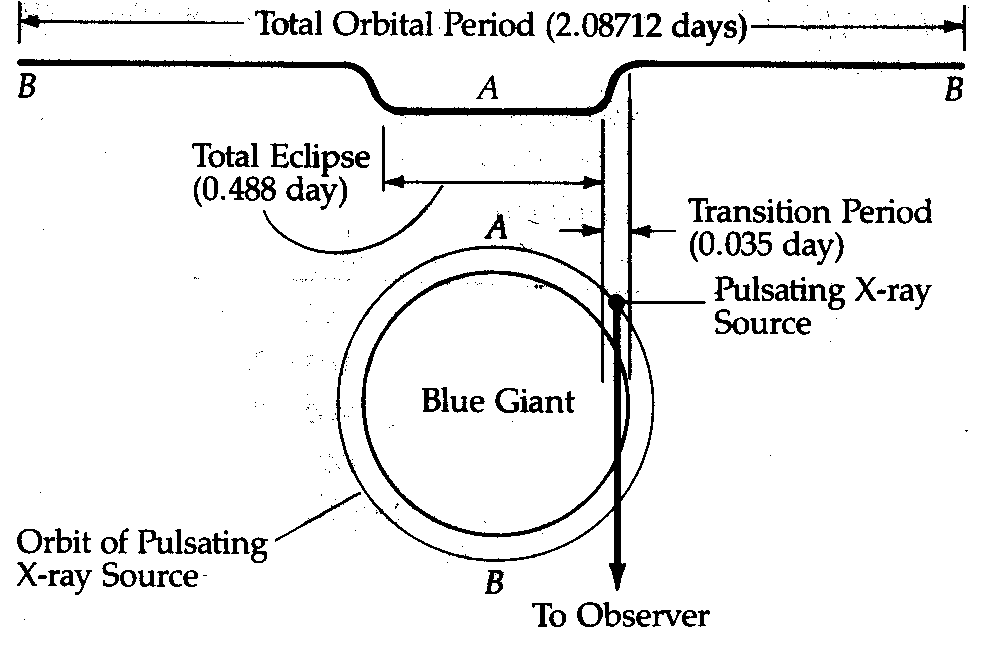 Figure 3-2-Ib
Model of the Centaurus X-3 binary system. (Adapted from a diagram by H. Gurskey8) This may be no coincidence in the case those heavy concentrated mass objects can only be hold by the central star if there are enough pushing gravity particles (see also Fig. 3-2-VI) that have relatively low “hit” chance because of the high density of the orbiting objects).
The mass of Centaurus X-3 is estimated at 1.5 MSun and it moves in an almost circular orbit around the blue giant at 415 km/s. Its orbit has a radius8 of about 11 x 106 km (the orbit of Mercury has a radius of about 25 x 106 km). If Centaurus X-3 would have had a lower density (but the same mass) then perhaps it would have fallen to the blue giant. (The mass of Centaurus X-3 may have been calculated too high by conventional science: a more dense object needs less mass to stay in the orbit of Centaurus X-3.) [February 2004: Of course, objects orbiting big stars at very short distances have to be compact or else they would have been destructed by gravitational forces. End February 2004] [May 2003: Gravity particles bend the velocity tracks of mass objects like our Moon (orbiting our Earth) stronger than photons. This may be due to photons being extremely compact (high density) and thus gravity particles can't get the same “grip” on a photon as they can get grip on, for instance, the Moon, a stone or a hydrogen molecule. With pushing gravity one may get differences between electrons, atoms and dust relative to each other. Also a dark matter object like a meteor may react different to gravity (particles) than dust. All because: with the pushing gravity particles concept the density of an object, dust particle, atom, ion or electron matters.
If one is able to say something about the magnitude of the gravity field of the Moon (and other celestial bodies like Mercury, Venus and Mars) from flux-measurements as shown in Fig. 2-2-V then this may assist adjusting the law of universal gravitation.
[May 2003: Many scientists have come with new gravitation formula's that you can check on. Read for example the books by professor Assis2 and professor Ghosh3 or various authors in Pushing Gravity5. End May 2003] The gravity field of the moon
The instability limit for our Moon, with the Sun as perturber, is 1.7 x 106 km. This value is calculated with the law of universal gravitation (F = Gm1m2/r2) looking at masses as point masses.
 Figure 3-2-II
Calculation of the instability limit of the Moon with only the volumes of the Sun and the Earth. If we take a look at Fig. 3-2-II we may try to estimate the instability limit as well, but now we don't take the masses of the Earth and the Sun as point masses, on the contrary, we don't bother ourselves about densities of the Earth and the Sun nor the masses of the Earth and the Sun, we use only the two volumes of the Earth and Sun for a certain calculation of the instability limit (whereas with Newton's law we don't bother about density nor volume and only use masses). In doing so we can calculate with simple geometry: distance Earth-X = 1.37 x 106 km and distance Earth-Y = 1.38 x 106 km. The instability limit will be further than these values like it is further then the value you get with Newton's law:
GmSunmMoon/rSun-Moon2 = GmEarthmMoon/rEarth-Moon2
which brings rEarth-Moon = 2.7 x 105 km. Hence the only with volume calculated instability limit will be in the order of the with Newton calculated number 1.7 x 106 km (but only a gravity formula with volume and density brings the right value).
[April 9 2005: The above “calculation” is to be seen as a beginning of trying to look different at gravity, i.e. in this case with taking the volume of an object into account when it comes to gravity. The above “calculation” is just mentioned as an opening to a new way of looking at gravity. End April 9 2005]
Principle of equivalence
If the law of universal gravitation should be adjusted with a density factor then Einstein's principle of equivalence is wrong.
[June 9 2005: I made a mistake here. I mistook the weak principle of equivalence for the strong principle of equivalence.
Russell Hulse and Joseph Taylor discovered in 1974 that the two neutron stars of the binary pulsar PSR1913+16 slow down their orbiting periods one second every year. Due to the general theory of relativity this is because the pulsars send out gravitation waves. But the real reason may be: the neutron stars slow down by gravity particles that cause inertial forces (3-2).
[May 2003: See also Assis2 and Ghosh3. End May 2003] Gravity particles being reformed into matter would solve the gravity riddle that says that gravity forces in an infinite universe would become infinite6.
[May 2003: Assis2 and Ghosh3 and various authors in Pushing Gravity5 give the same solution (i.e. absorption of gravity) for the gravity riddle. End May 2003] Gravity as a repulsive force may explain why in an atom - charged electrons don't fall on the + charged nucleus: because the repulsive gravity forces (by gravity particles flowing out of the subatomic masses) may become very strong when the distance between two particles becomes very small.
[May 2003: "In the early 20th century Hugo von Seeliger (1909), Kurt Bottlinger (1912) and Quirino Majorana (1919, 1920) proposed a new kind of model, assuming that all bodies emit in all directions particles (or waves) of a special type that produce gravitational forces." Roberto de Andrade Martins in Pushing Gravity5. End May 2003] Push two half spheres against each other and pump the inside of the sphere close to vacuum: you need strong forces or much energy to pull the two half spheres from each other, or: there must be a mechanism/force that holds the two spheres together, a force that pushes the two spheres to each other. Something like this may work on a subatomic level as well. Perhaps gravity particles push protons and neutrons together and thus a nucleus in an atom is hold together very strongly. But as soon as a (small) part of the nucleus is at a certain distance of the nucleus then that part(icle) may get blown away from the nucleus very fiercely by gravity particles. Thus nuclear binding energy may not be mass turning into energy, but: a particle of the nucleus getting very much speed by gravity particles (because certain gravity forces no longer rule each other out by pushing very hard from all sides to the dense sphere of multiple neutrons/protons). This would also explain why fusion is so hard: two particles must overcome the force by gravity particles that keeps them apart, but as soon they are “through” that force and joined then gravity particles push them very strongly together. This way nuclear binding energy can be understood in a very simple way. [May 2003: Jones (1987) and Byers (1995) have given arguments supporting Le Sage-type shielding (which is the same as what I am referring to here) as the source of the strong force binding nucleons, see Edwards in Pushing Gravity5. End May 2003] [June 11 2005: This would mean that inside our body subatomic particles are under enormous pressure (think of the energy that comes free in atom bombs) by smaller particles. We don't feel this because the smaller particles push from all sides at subatomic particles (this also goes for gravity, we only feel the net result of the gravity caused by the mass of the Earth, but inside our body gravity particles may squeeze (certain) subatomic particles very hard).
[June 9 2005: What causes two half iron spheres to be pushed very hard against each other when the inside of the sphere is sucked vacuum? The absence of air molecules inside the sphere brings a force that pushes very hard against the two half spheres from outside the sphere, at least that is how I look against it. What kind of force can that be?
[April 2 2005: One may argue that the Moon falls on the Earth when it comes near by the Earth (while not having much speed orbiting the Earth), i.e. there is no repulsive force when the Moon comes near the Earth (as with two protons or with a proton and an electron). But there is a difference between the Earth/Moon and two protons or a proton and an electron. If there is such a thing as gravity particles then probably most of them will fall through the Earth and the Moon without interfering with the Earth or the Moon. Protons and electrons are much more compact, which makes things different. If gravity particles are absorbed by protons and electrons then protons and electrons ought to throw them out again too, which then may account somehow for a repulsive force at a close distance between two protons are between a proton and an electron (for instance, perhaps gravity particles are (more) thrown out in the direction of the (other) proton/electron because no/less gravity particles come from the (other) proton/electron; perhaps such a thing is possible on a subatomic (more compact) level).
Of course I give very primitive ways to try and understand certain observations we have made. But at least it is about understanding. Newton gave a name to a certain force (i.e. gravity), a force that makes a thea cup out of our hands fall to the ground, but he did not explain why the thea cup falls. The same with things like the strong nuclear force, weak nuclear force and electric charge, which are names for forces we see at work through observations, but what about understanding how and why such forces work the way they do? Before you can get into more complication to understand how the here mentioned forces work you have to start with very simple things to be able to make a start. That is what I try to do in this chapter. Actually it is what I try to do throughout this whole website. End April 2 2005] There may also be repulsion by gravity particles coming from outside the atom which paths get bend (see Fig. 3-2-III) because the gravity particles pass the nucleus or electron of the atom at a nearby distance. Thus nearby particles, like an electron and a nucleus, or like a helium nucleus leaving an uranium atom, may repulse each other too, next to, as mentioned above, gravity/ether particles coming out of particles like, for instance, protons and electrons, plus gravity/ether particles coming from outside the system and not getting bend (like in Fig. 3-2-III). This would imply necessity for smaller particles than gravity particles in order to bend the gravity particles' direction. 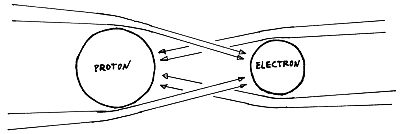 Figure 3-2-III
Repulsion between proton and electron because of (bending of) gravity particles coming from outside the atom. Subatomic rotation
Subatomic rotation may continue due to gravity/ether particles (coming from all sides outside the atom, or rather: outside the subatomic particle) that give the energy for rotation, or/and subatomic rotation may continue due to gravity/ether particles leaving the subatomic particle.
Subatomic movement of an electron (around the nucleus in an atom) too may be due to gravity/ether particles that push the - electron to and fro the + charged nucleus of an atom. But also: there may be gravitational shielding by the nucleus of the atom, thus causing the electron to rotate/spin because one side of the electron gets much more hit by gravity particles coming around one (“horizon”) side of the nucleus; like a top that's getting whipped. With gravity/ether particles as a repulsive force mass-particles can rush away from each other and so baryonic matter may come to existence out of “nothing”, or: out of gravity particles (perhaps together with other non-baryonic particles like neutrinos and photons).
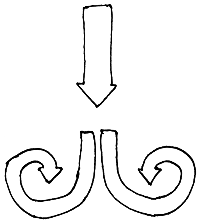 Figure 3-2-IV
An example of how baryonic mass may come to existence. A primitive example of how baryonic mass may come to existence out of non-baryonic particles is shown in Fig. 3-2-IV. A stream of non-baryonic particles happens to flow (by coincidence or some force) in one direction. With repulsive ether forces in the bundle of particles (which, again, may show necessity for smaller ether particles than gravity particles) the bundle splits up in two particles, both with a certain spin, that rush away from each other. Strong gravity can cause matter to come to existence in vacuum (as tests in laboratories have shown6). Perhaps dark matter can be, somehow, the cause of baryonic matter coming to existence.
[May 2003: In an infinite (both in time and space) universe there has to be a mechanism that brings photons back into baryonic matter. I have found another, to my opinion much simpler and more plausible, mechanism that can produce baryonic matter. This hydrogen production mechanism is explained in 5-2 and 6-1. In books and websites by dissidents I didn't see a hydrogen production system in empty space without dark matter playing a substantial part. But I did see some suggestions for hydrogen production with dark matter (or rather: baryonic matter as in our Earth). Edwards and Kokus each describe a hydrogen production mechanism (which differ from each other) in Pushing Gravity5, with dark/baryonic matter having a substantial part in the hydrogen production. End May 2003] Non-baryonic matter abundance
Neutrinos (having non-zero rest mass) are often suggested as the cause of the missing non-baryonic dark matter in the universe. If gravity/ether particles have non-zero rest mass than this too may help to solve the non-baryonic matter abundance problem.
[May 2003: This problem may already vanish by throwing the idea of a big bang overboard. End May 2003] Gravity particle loops
Magnets may attract each other by loops of certain particles, see Fig. 3-2-V.
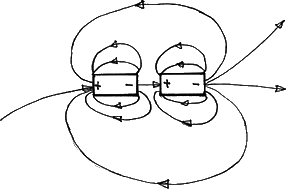 Figure 3-2-V
Magnets attracting each other. Perhaps gravity (for example gravity of stars, see Fig. 3-2-VI) works with loops of gravity particles (next to gravity particles coming from all sides from the rest of the universe), but then without a particular south and north pole as in the case with magnets. [November 2003: Gravity/ether particles in higher concentrations around a mass object like our Sun or our Earth as shown in Fig. 3-2-VI may explain the ether concept (2-1), i.e. it may offer a way of understanding why gravity particles cause photons from stars to adjust their velocity to the velocity of the Earth in its orbit around the Sun. End November 2003]
[February 2004: Perhaps that every mass is surrounded somehow by smaller masses, i.e. also a neutron, or a photon, or an electron, or even a gravity particle. Smaller particles concentrating around gravity particles may also be surrounded themselves by even smaller particles, etc. This way there may be no end to smaller particles, up to infinity. As written in chapter 1-2: infinity is something we can not understand, by definition, because we, as humans, are finite, i.e. we die. End February 2004] Figure 3-2-VI
Two gravity particle streams: gravity particles coming out of two stars (only some loops for star A are drawn) and gravity particles coming from the rest of the universe (particles from the universe are only drawn around star A). Loops of gravity particles would, again, show necessity for particles smaller than gravity particles in order to make the gravity particles bend. This bending would mean: gravity particles are attracted to mass (because of pushing by smaller particles than gravity particles, see Fig. 3-2-III).
[June 13 2005: With more gravity particles assembling themselves around mass concentrations one may explain the refraction of light. Light may be bend by gravity particles or smaller particles towards the medium that is “heavier”. Glass is “heavier” than air. When a photon goes from air to glass then just before it enters the glass it may be bend towards the glass because it is pushed towards the glass by gravity particles or smaller particles than gravity particles. When it leaves the glass then it may be bend towards the glass too just after it has left the glass. This may explain why there is no refraction when light enters the new medium perpendicular, and why the refraction becomes larger when light enters the new medium less perpendicular (because then the pushing small particles have more chance to bend the path of the photon).
[June 2004: When cosmic microwave background radiation gets lower temperatures when the cosmic microwave background radiation photons pass through relatively strong gravity fields (1-2) then this may be a confirmation of Fig. 3-2-VI, i.e. gravity particles may concentrate themselves around strong concentrations of matter like a planet, star, galaxy or cluster of galaxies. Without a concentration of gravity particles as suggested in Fig. 3-2-VI it may be very hard to understand what a stronger gravity field exactly is and how a stronger gravity field can account for a stronger tired light redshift. End June 2004] [December 2004: With gravity particles concentrating themselves around strong concentrations of matter like a planet, star, galaxy or cluster of galaxies as suggested in Fig. 3-2-VI one may suspect that the gravity we experience would become stronger when we (in an imaginary short time) would travel with our Earth from the outskirts of our Milky Way to the center of our Milky Way. End December 2004] An atom is more empty than our Solar System, this may mean that though we can not “see” it (by measurements) there may be more and more smaller particles on smaller and smaller levels. There may be no end to smaller and smaller and smaller (classes of) particles (or particle levels)... there may be no end to smallness, like our universe may be infinite large (i.e. perhaps that every cluster is part of an even larger cluster).
[February 2004: In chapter 4-1 it is argued that galaxies and clusters shrink and that the shrunken galaxies become the centers of future galaxies. Now take a cluster of galaxies in mind. The centers of the galaxies in the cluster originate from a much bigger cluster that has shrunk. But the centers of the galaxies of that bigger cluster originate from galaxies of an even bigger cluster of galaxies that has shrunk, and the centers of the galaxies of that even bigger cluster, etc. Though, perhaps this way one can reason that there are always bigger clusters to be found. Perhaps that this does not necessarily mean that the universe is not homogeneous filled with galaxies when you look at the Universe on extremely large scales.
[May 2003: Smaller particles may be faster particles, playing roles on both deeper (=smaller) subatomic levels plus deeper (further away in the Universe) space levels. Thus there may be deeper and deeper ether levels and one may never know if there is a possible deeper level to be found, no matter how far intelligent life has evolved. End May 2003] Also electric charges may have some kind of loops of certain particles (for a primitive example: see Fig.3-2-VII).
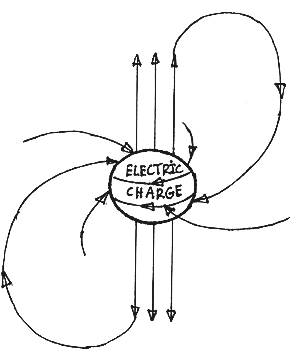 Figure 3-2-VII
Electric charges may have loops. If there is only mass plus movement of mass everything can be understood by mass plus movement of mass, also on the deepest subatomic level, also concerning electrical charge.
For example: imagine that a + charged particle consists of (streams of) gravity (or even smaller ether) particles in such a way that it repulses other + charged particles and attracts - charged particles. Such a, very primitive and very most likely wrong, example is given in Fig. 3-2-VIII (this example too shows necessity for particles even smaller than gravity/ether particles in order to make the gravity/ether particles bend). The + and - particles rotate plus continually send out smaller (gravity/ether) particles and continually receive (gravity/ether) particles, thus + and - particles may attract each other and particles with the same charge may repulse each other. 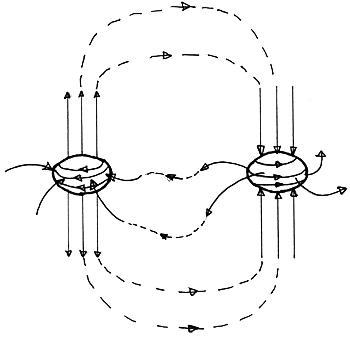 Figure 3-2-VIII
Example of how movement of mass may cause attraction between + and - charge. Hydrogen electron vibrations
In 1962 Blamont and Roddier measured that hydrogen electrons vibrate a little slower on the Sun than on the Earth due to the different masses of the Sun and the Earth10.
The slower vibration on the Sun may be caused by more gravity/ether particles (see also Fig. 3-2-VI: baryonic mass concentrations may result in higher gravity/ether particle concentrations) slowing down the electrons. Our Solar System has a place in our Galaxy (see Fig. 3-2-IX). 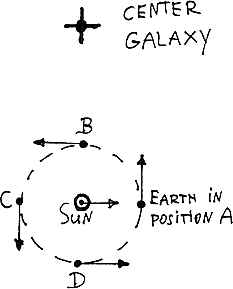 Figure 3-2-IX
Our Solar System in the Galaxy. Electrons on Earth may have different vibration rates depending on the place of the Earth in its orbit: flows of gravity particles in our Galaxy may cause different vibrating rates of electrons in hydrogen atoms. If the vibration rate is also caused by the direction of velocity of objects (like our Earth at different moments in its orbit around the Sun) in our Galaxy then: differences in vibration rate may be found with the Earth in different positions in its orbit (see Fig. 3-2-IX), when the positions are compared with the (more constant) vibration rate of electrons in hydrogen atoms on the Sun.
My guess is that the slowest vibrations are to be found with the Earth moving away from the center of the Galaxy (position C in Fig. 3-2-IX), due to the velocity of the Earth compared to the direction of the largest gravity particles stream: many gravity particles coming from the universe will be absorbed in the nucleus of the Galaxy, so in position C the Earth “runs into more” gravity particles that go to the galactic nucleus. For the same reason: electrons in hydrogen atoms moving up (from the Earth) should vibrate a little slower than electrons in hydrogen atoms moving down (to the Earth). [May 2003: See also Hatch's work4 about atomic clocks being in all kind of positions. Vibration rates of electrons in hydrogen and (vibration rates in) atomic clocks both may represent the amounts of gravity/ether particle “hit-rates”.
Newton's first law may be explained by gravity particles and smaller particles.
Imagine a planet like our Earth (or rather: a single dark matter object) moving with constant velocity through intergalactic space. Something has to push the planet or else the planet would be stopped by a single intergalactic atom that would bump into the planet. What can that driving pushing force be? If there are smaller particles that push gravity particles towards mass than those smaller particles have more time to push a certain gravity particle to a (baryonic) particle in the planet when the gravity particle comes from “behind” the planet, i.e. when the gravity particle moves in the same direction as the planet is moving (see also the bending mentioned with Fig. 3-2-III). Thus the number of gravity particles coming from “behind” the planet may have a higher “hit-rate” than gravity particles coming from other directions. Perhaps it is as simple as that. End May 2003] [November 2003: With gravity particles everywhere one thus can say that there is never a moment for a body when there are no forces working on the body. Then the concept inertial force is not inertial at all: if a body goes through intergalactic space with a constant velocity there are forces (i.e. gravity particles) working on the body all the time. If not then the smallest particle would be able to stop the (velocity of the) body. End November 2003] [April 22 2005: Cosmic rays can be atoms or electrons going extremely fast through space. Also atoms and electrons may be pushed forwards by the here mentioned “inertial” force. But perhaps also photons may be propagated by the same principle (see also 2-2). End April 22 2005] Energy electrons
The energy of an electron can drop because of the release of a photon. Only under certain conditions an electron is able to “throw out” a photon, which may be a certain amount of gravity/ether particles. When the electron is heated the number of gravity particles in the atom may be raised somehow (next to the higher velocity of the electron?), thus raising the energy of the electron.
[May 2003: Various authors in Pushing Gravity5 suggest that radiation of photons may be a way for mass to avoid overheating by absorption of gravity particles. End May 2003] [July 2004: See also 6-2. End July 2004] Also: perhaps light waves “erode”, or: lose gravity/ether particles, when they redshift (and gain gravity/ether particles when they blueshift).
High speculation on the second law of thermodynamics
If gravity particles (and/or radiation and/or some other form of matter) can turn back in hydrogen atoms somehow without the help of dark matter/baryonic matter then the second law of thermodynamics is wrong. (The second law of thermodynamics is already violated by all living biological organisms, anyway.)
According to 1-1 there is a chance that we may regard gravity particles (or photons or neutrinos) too as living. Thus there may be some will somehow that may cause gravity particles (and/or radiation and/or some other form of matter) to return into hydrogen atoms. This could put gravity particles' most profound basis on the same level as biological systems: desire for happiness acting against the second law of thermodynamics.
If gravity particles (and/or radiation and/or some other form of matter) came to existence due to matter coming out of completely nothing then this would violate the principle of energy conservation. Even if we ever would proof that gravity particles (and/or radiation and/or some other form of matter) can turn back into hydrogen atoms then we still don't know if there is a more profounder thing underneath, i.e. the possible creation of matter (gravity particles, or even smaller particles) out of completely nothing (and, of course, vice versa).
One may never know if there is something like completely nothing, one may never know if the principle of energy conservation is wrong or right. This is the same as: one may never know if there is a smaller class of particles to be found. There may be some kind of equilibrium in the Universe concerning “free” gravity particles and other non-baryonic matter turning into “bound” particles (for instance in the form of protons) and vice versa, like there may be an equilibrium concerning dark (baryonic) matter versus luminous (baryonic) matter (4-1). Superconductivity
Superconductivity starts at very low temperatures. If gravity/ether particles cause repulsion, perhaps at very low temperatures this repulsion stops because then gravity particles stop causing certain forces.
In intergalactic space very low temperatures may be reached which perhaps triggers some kind of physical evolution of extremely premature life, i.e. hydrogen production or production of (much) smaller particles. [May 2003: Inertial/gravity effects involving high voltages and superconductors are being investigated by Podkletnov's team in Moscow. Also NASA and several laboratories worldwide research gravity-superconductivity relations. See Hathaway in Pushing Gravity5. End May 2003] |
